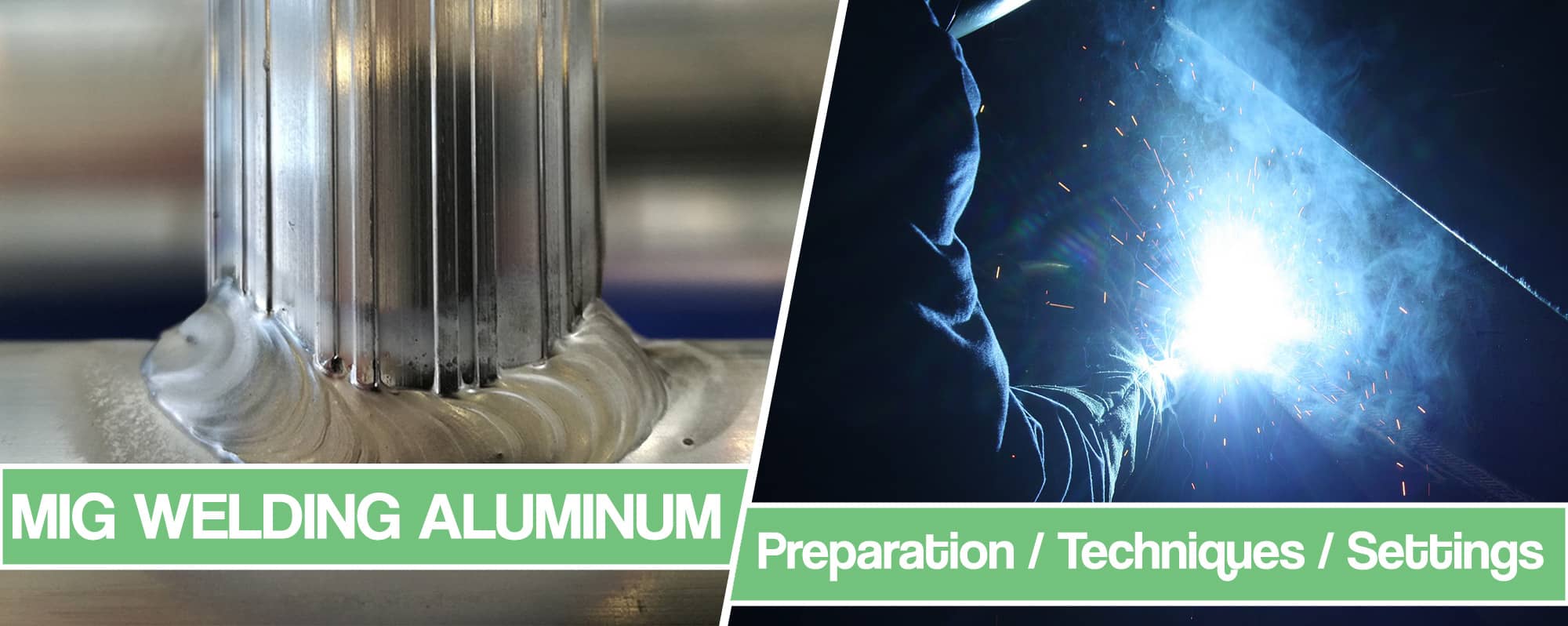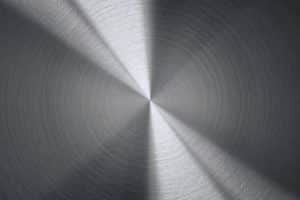Believe me when I tell you that MIG welding aluminum can be a tedious task if you are not prepared for it.
I have heard a lot of people telling me that they had so many problems doing it that it eventually forced them to give it up.

The truth is that being able to MIG weld aluminum isn’t hard at all. But in my case, I had to invest a certain amount of time to be able to do it properly.
I am at a point where aluminum welding has become second nature to me. However, that comes with years of experience and a lot of aluminum metal pieces welded together. My experience is that using proper equipment, a decent welder, and employing proper technique will get you where you need to be.
Aluminum MIG welding is similar to welding mild steel to a certain point. But there are a few changes in tactics that have to be employed. This is why we are here today as I am about to tell you how I do it and what you need to keep an eye out for as a beginner welder.
Basics of MIG Welding Aluminum
In its pure form, aluminum is quite a soft metal, which is where the challenges of welding it lie. Welding aluminum requires the inclusion of other alloys to increase its strength which then makes it useful for multiple purposes.
Its properties are very different when compared to steel, therefore making MIG weld aluminum a bit of a challenge. If proper technique is not applied, it is susceptible to distortion as it is sensitive to heat. I recommend sticking to the right equipment and proper technique as best practice. To see the top welders for aluminum refer to our round-up review and buying guide.
In our overall top MIG welders guide, we reviewed the Hobart IronMan 230 which we think is one of the best MIG aluminum welders and it comes with a spool gun.
Weld Preparation for Aluminum MIG Welding
Preparing well before you start is the key to success when welding aluminum. Basically, you need to thoroughly clean the weld material and surface before you start. Choosing the right shielding gas and electrodes is simple but also important. I recommend using a spool gun and applying spray transfer, but more importantly, carefully adjusting the settings on your welder.
Thickness of aluminum plate for MIG Welding
The output capacity of your welder will determine the thickness of aluminum that you can weld. Basically, you can MIG weld aluminum thickness of 14 gauge or heavier. But thinner than 14 gauge, or .074 inch, requires a little bit more tinkering and using specialized pulsed MIG or AC TIG welding equipment.
Removing the Oxide
Aluminum oxide removal needs to be done before you start working and degreasing. I say do it with a hand wire brush or a cup wire brush.
A power wire brush can be used, but don’t go overboard on the rmps so as not to smear the surface of the material as it may entrap oxide and other impurities under it.
A proper aluminum wire brush should always be used to avoid contamination.

MIG Welding Aluminum Filler Wire Selection
Before choosing the correct welding wire, you need to know the exact alloy of the base aluminum you are working on and to which conditions the finished piece is going to be subjected. Your best choices of aluminum wire are ER4043 and ER5356. But I do always recommend contacting your local distributor for recommendations on wire alloys that fit your application.
An aluminum wire thicker than .035 needn’t be used. The ER5356 aluminum wire is much stiffer than the ER4043 wire. The stiffness may also affect how the wire feed system behaves when working
MIG Welding Aluminum Spool Gun
A spool gun and a proper wire feed speed system need to be employed. You can’t just put a roll of aluminum wire in your MIG machine. Aluminum wire is much softer than steel and a spool gun helps in compensating for its softness. The soft wire tends to birdnest inside the cable liner of the wire feed speed system. The wire isn’t as stiff as the mild steel wire.
A proper spool gun with a small 1 lb. roll inside it is the best choice. The wire doesn’t have to travel through the MIG hose and get ratted up during wire feed. However, there are some MIG welders out there that weld aluminum without a spool gun.
They have a special liner throughout the wire feed system which allows the use of aluminum welding wire in a MIG machine. Here is a nice video from Eastwood about using the spool gun and some other general tips.
Push-Pull Gun
A push-pull gun can be of great help. It has a motor that pulls the wire through the liner while the feeder control acts as an assist motor. The push-pull system helps to eliminate birdnesting by constantly maintaining tension on the wire.
Furthermore, it is more ergonomic compared to the spool gun because the weight of the spool is not in the welder’s hand. You also don’t have to change the spool so often.
MIG Welding Aluminum Gas Choice
When it comes to gas choices for aluminum welding, there are differences from when working on mild steel. Mild steel welding usually involves C25 gas, which is a 25% CO2 and 75% argon mix. However, MIG welding aluminum works best with a 100% argon shielding gas.
It involves using the spray transfer process with a flow rate of 20 to 30 cubic feet per hour for proper gas coverage. But if you are planing on welding thicker pieces of aluminum, 1/2” or more, 25% to 75% helium should be added for deeper penetration to be achieved.
Basically, 100% argon is used to keep the weld clean and free from oxidation. Helium is used to increase penetration ability when welding aluminum.
Polarity for MIG Welding Aluminum
My advice is to always have your welder set on direct current electrode positive (DCEP) with aluminum MIG welding. This type of polarity setting is also called reverse polarity and involves electrons going through the ground cable and back to the gun. Failing to set everything correctly will result in poor welds.
If you want to create a proper weld, preparing everything before aluminum MIG welding is important. This involves cleaning both the base material and the surface that you are going to work on as thoroughly as possible. Be sure to clean any particles or lubricants before you start.
Even the slightest contamination may lead to porosity and creating an improper joint.
MIG Welder Settings
I already mentioned that the desired way of MIG welding aluminum is with the spray transfer method. In terms of position, the settings are completely the same. You can set it somewhere between 21 to 23 volts to start the arc.
Spray transfer allows a smooth transfer of molten droplets from the electrode to the molten weld pool. This method also avoids short-circuiting while maintaining high efficiency and deposition rate. Unfouratnely, spray transfer creates a lot of heat which could result in a weld puddle that is difficult to control. Never use it for materials thinner than 14 gauge.
MIG Welding Aluminum Tips and Techniques
Using MIG welding techniques for aluminum is no different compared to welding steel. The biggest difference is when welding out of position and the speed. Welding in position gives you more time to react if things don’t go your way.
Travel Speed for MIG Welding Aluminum
The best type of advice I can give is using the same voltage settings with mild steel but doubling the travel speed. Aluminum MIG welding requires a welder to move around, especially with your MIG gun and for the wire speed to push the wire into the joint. If it starts slowing down, you may end up with a fused tip.
Push or Pull Technique
Aluminum MIG welding requires the use of the forehand or push direction. This ensures proper gas coverage of the weld puddle. Pushing results with a wider bead with less penetration, while dragging creates deeper penetration but a narrower bead.
MIG Aluminum Welding Tips
Here are some prime tips that I have prepared:
- The contact tip should be recessed approximately 1/8 inch inside the nozzle while maintaining proper tip-to-work distance.
- A 10- to 15-degree push travel angle should be used.
- Avoid large weave beads on aluminum.
- Holding the contact tip too close could result in the wire burn back.
Common MIG Aluminum Welding Problems and Solutions
Here are some helpful pieces of advice that could help you resolve common problems with aluminum MIG welding.
- Burn through – Increase the travel speed and make shorter welds. Spread the heat around, use thicker metal, switch to AC TIG welding, or change the joint design.
- Dirty welds – Use a push technique instead of a drag angle. Increase voltage for better spray transfer.
- Wire burn back – Keep the safe wire-to-work distance. Check the size of the contact tips, gun liner of the MIG gun, drive rolls, and wire diameter.
- Wire birdnesting – Check the drive roll tension, the wire diameter, and the pressure adjustment on the spool gun.
Good VS Poor Aluminum Welds
Creating a proper aluminum weld can be hard to achieve thanks to the unique properties that the material has. Aluminum conducts heat six times faster than steel and has great thermal conductivity. Aluminum wire has less tensile strength and can create certain wire speed feed issues that could lead to weld defects.
Frequently Asked Questions
Can MIG Welders weld aluminum?
Yes, MIG welders can be used to weld it, but you might need an optional spool gun or a higher wire feed speed.
What gas is best for welding aluminum?
Pure argon gas is the most recommended type, as it offers the best puddle protection from impurities.
Is MIG better than TIG for welding aluminum?
The MIG method is the one that most welders prefer using, but TIG is also used especially for clean and quality welds but takes a lot longer to complete. MIG welding aluminum is easier, while TIG welding can produce better quality welds.
Conclusion
This is all the wisdom that I have for you and hopefully, you will be able to use it. As my experience was able to prove, this can be a tricky type of metal to weld and controlling the weld puddle is not an easy task by all means. But with proper technique, equipment, and some practice it is all quite possible.
- Aluminum Alloys 101 at www.aluminum.org
- Aluminum Welding Procedures at www.brazing.com
- How to weld aluminum at www.uti.edu
- The Welding of Aluminium and its Alloys by Gene Mathers





